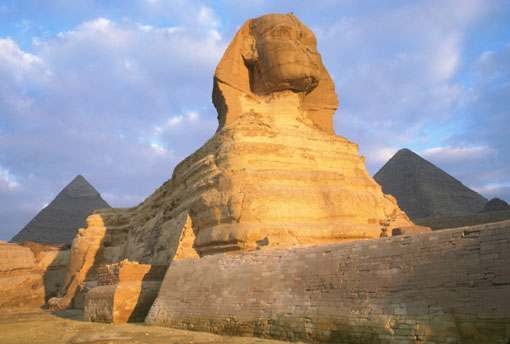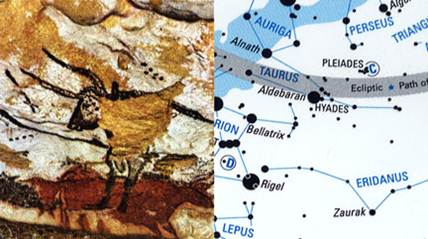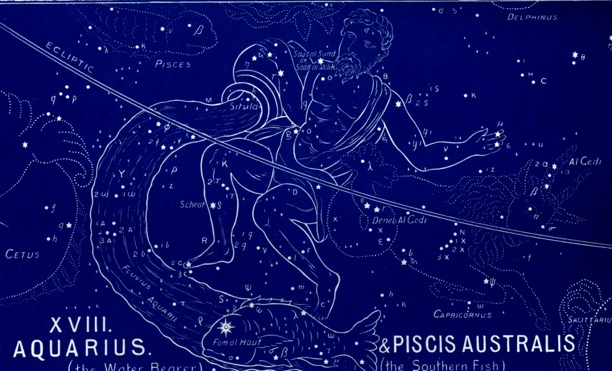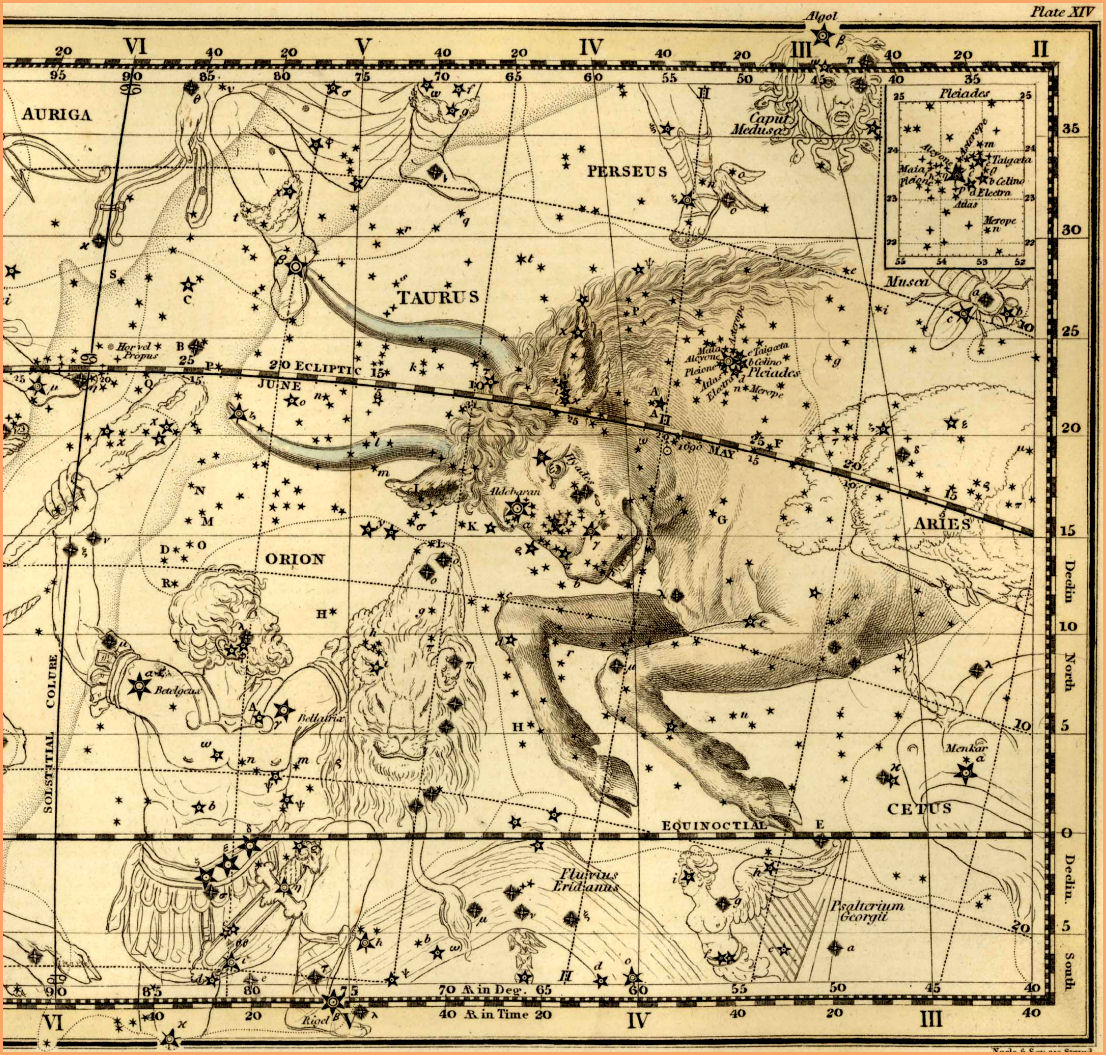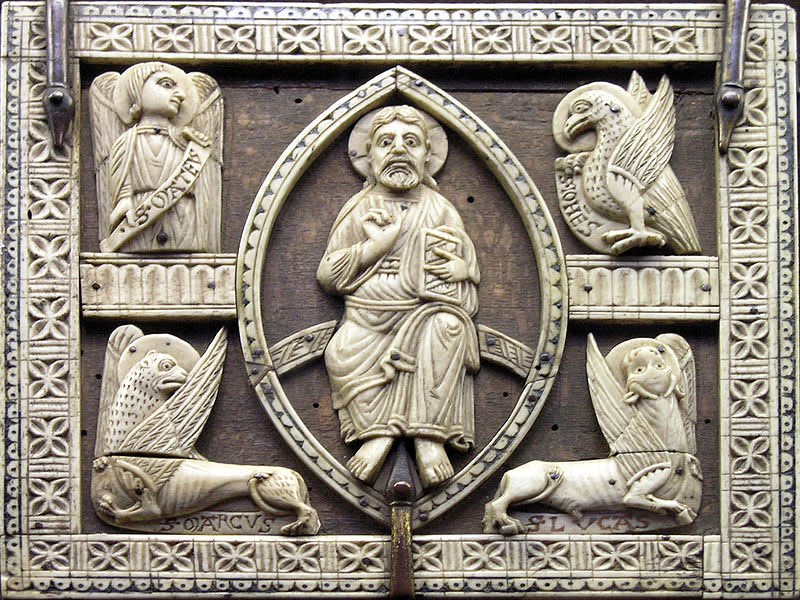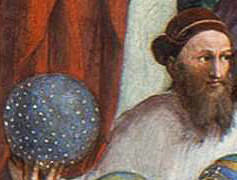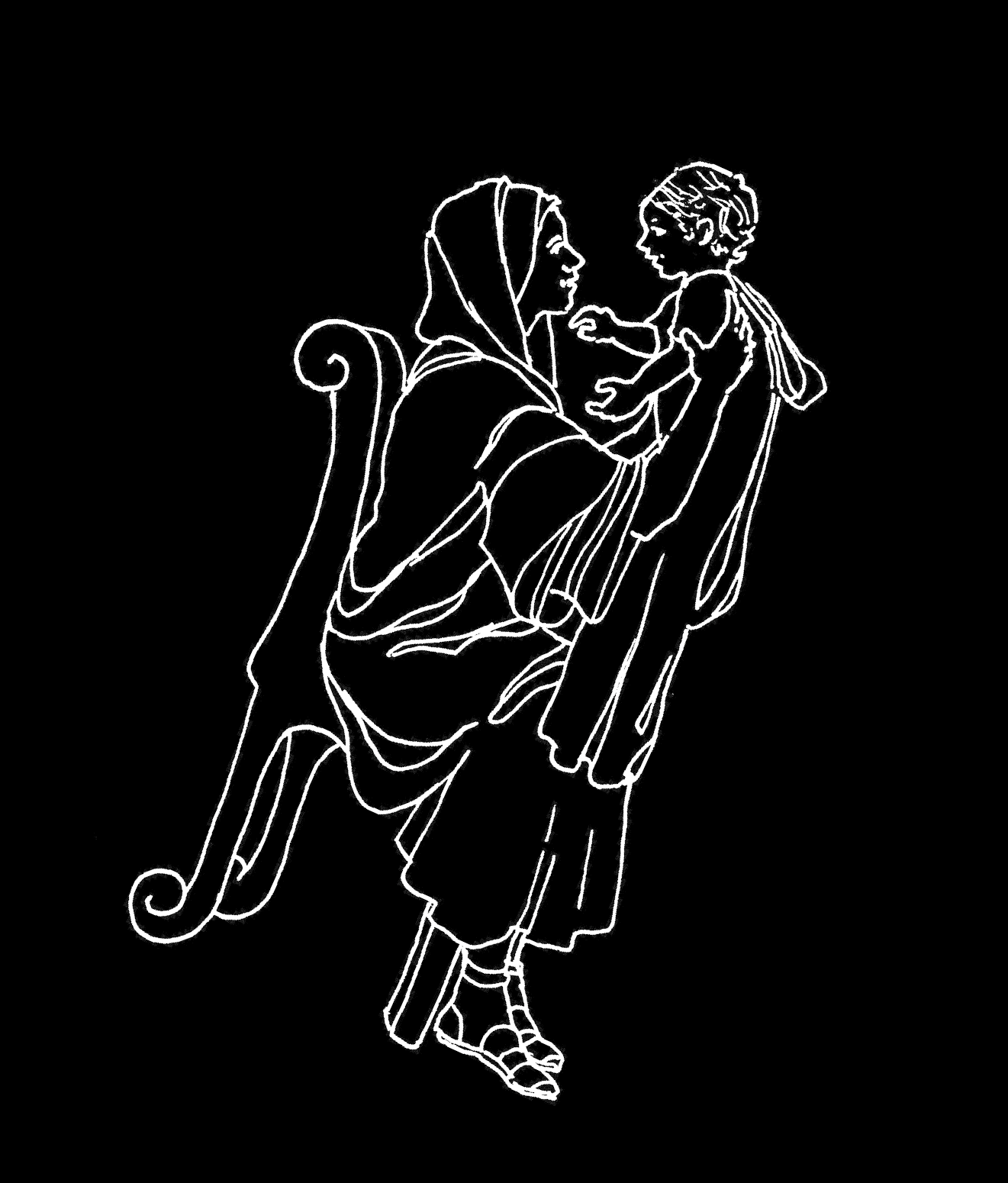
A Deeper Perspective on the Precession of the Equinoxes
Welcome to the Sept. 2024 blog! With the change of Seasons from Summer to Fall it reminds us of how the Heavenly Father has placed us in a temporal world, where change is the ever-present standard of the Ages of our World. Those who seek to honor God in our lives and follow the example of His only begotten Son; Jesus Christ, will take this opportunity to put off the old man, and put on the New, so we can participate in transforming ourselves into more Christlike people. In this process, it’s certainly great to have the spiritual body of Christ’s Church to grow into, as we daily approach the Return of the Lord. This month’s study provides the temporal context of this lifetime journey… God tells us in Ecclesiastes 3:9-15 [Amp. Bible]
9 What profit remains for the worker from his toil? 10 I have seen the painful labor and exertion and miserable business which God has given to the sons of men with which to exercise and busy themselves. 11 He has made everything beautiful in its time. He also has planted eternity in men’s hearts and minds [a divinely implanted sense of a purpose working through the ages [the world related to time], which nothing under the sun but God alone can satisfy], yet so that men cannot find out what God has done from the beginning to the end. 12 I know that there is nothing better for them than to be glad and to get and do good as long as they live; 13 And also that every man should eat and drink and enjoy the good of all his labor-it is the gift of God. 14 I know that whatever God does, it endures forever; nothing can be added to it nor anything taken from it. And God does it so that men will [reverently] fear Him [revere & worship Him, knowing that He is]. 15 That which is now already has been, and that which is to be already has been; and God seeks that which has passed by, [so that history repeats itself]. [Prov. 3:11-23]
If only we humbly reach out to Almighty God on His terms, can we gain a deeply valued perspective in understanding the works of His hands in His Creation. In this Biblical sense and context we resume our search for a deeper meaning behind the Astronomical Phenomena that rules over the ages of the world, known as the Precession of the Equinoxes.
The history of Biblical Astronomy gains new insights as we view the Biblical context of the Patriarchal astronomers, starting with Adam regarding their view of the heavens. God’s revelation of His Intelligent design of the cosmos, was taught to Adam-the 1st Man initially, and passed on to Biblical Patriarchs and others, during Adam’s 930-year life span. During the transmission of this revelation, it retained its accuracy since it was transferred from God to Adam in the same generations it was received, before Adam taught it to others. The Revelatory Astronomy of God depicting the poles, ecliptic and Equator, all arising from the direction of the Earth’s axis, exhibit critical aspects of the Precession of the Equinoxes as a key part of God’s plan of a figurative geocentric position of Earth’s central location in the heavens. Since Earth was the only celestial body inside the firmament in the 1st Heaven and Earth, with Mankind not yet created, only Angels lived to serve the Almighty. This speaks not only to the Precession of the Equinoxes, but also the Precession of the Pole star related to the shifting Ages, as seen on top of Figure 1 below. As we view the Creator’s original plan of Creation, in 3 Heavens and Earth’s, a benefit of this study affords readers an updated view of the Precession of the Equinoxes; that lays out a precessional timing of the Ages and events opening the Second Heavens and Earth. As a result, new light is shed on these events and temporal periods, in the context of the 1st Heavens and Earth, not only from a Biblical view, but also a historical vantage point.
In the Figure 1 graphic of Precession provided below, we find eight of the 12 signs of the Mazzaroth, or Constellations of the ecliptic labelled. Following the sign Cancer in the blue rectangle of the ecliptic band, is a blank yellow rectangle where the sign for Gemini-the so-called “Twins” belong. The next brown box keeps space for–Taurus the Bull. After Taurus we find an orange rectangle for Aries the Ram. In the long march of 12– 2,160 year-Precessional Ages, this Age of the Ram directly preceded the Age of Pisces the Fishes. This is our current Age of Precession, as we have already seen 2000+ years of the 2,160 years of the Piscean Age, that opened with a 7 BC triple conjunction of Jupiter-Saturn, as part of the Celestial Prelude that set the stage 3 years later for the Jupiter-Regulus triple union in Leo marking the 3BC birth of Christ.
Figure 1. Precession of the Equinoxes. #1
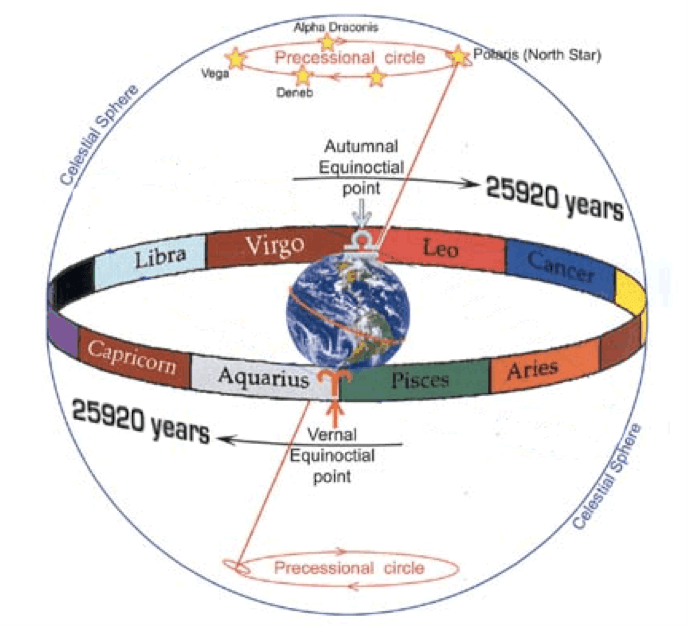
As we proceed in this study, we will see how the 12 signs of the Mazzaroth or Zodiac are represented in the ancient Egyptian Dendera Zodiac, that itself prophesied of the birth of Christ. This also depicts one way that the Great Sphinx prophecy of the birth of Christ, not only relates to Dendera’s witness of Christ, but also of how Precession is the ultimate Zeitgeist, or Spirit of the Times-as each of the 12 constellations or signs carry their own symbolic weight, in relating the message of the Celestial Gospel, as we find in greater detail below.
Looking at the Creation record in Genesis 1-2, we do not find reference to the Creation of Angels, during the Creation Week, because God already created the angels, who pre-existed this Age with Lucifer as his “morning stars,” seen in [Job 38:4-7, Jude 6, 9, Rev. 12:3-4], in the first Heaven and Earth. We know of 3 Heavens & Earths since the Apostle Paul was “caught up” [2 Cor. 12:2-4] to a 3rd Heaven, [G3772–ouranos; used in both singular & plural interchangeably, referring to tiers of space above earth’s surface, where fowls of the air fly; (Mt. 6: 26), and clouds form rain (Mt. 24:30, Js. 5:18), under the celestial motion of the Sun, Moon and Stars; [Mk. 13:25].#2 Above temporal limits is a restricted dwelling of Holy Angels & God, outside of and separate not only from our own Age-time, in a Second Heavens and Earth, but detached from a previous Age, before man was created. These 3 Heavens & Earths occur in a time sequence, starting “in the Beginning“ in Gen. 1:1, and 2 Pet. 3:6, as “the world“ [G2889-kosmos: sum total of a material universe with all inhabitants, people or space, #3, versus [G165–aion: Mt.12:32, 13:39-40, end of distinct world-ages].#4 The world that was then,” that “became formless & void” in Gen. 1:1-2, when an unknown length of time between the destruction of the 1st Heavens and Earth, and the events of the Creation Week in the 2nd Heavens and Earth occurred. 2 Pet. 3:7 says “the Heavens and Earth which are now,” takes us into the present Age in the 2nd Heavens and Earth, while 2 Pet. 3:13; links us to a 3rd Heavens and Earth-still future, [Isa. 65:17, 66:22-24] that God exposed to the Apostle Paul-[2 Cor. 12:2-4], wherein dwells righteousness.
Fig. 2. The Layers of Earth’s Atmosphere inside a 2nd Heavens and Earth.#5

In Gen. 1:6, we find the initial usage of “tavek” in God’s Word. The first occurrence of this word refers to God’s order in the firmament, as He Divided the waters of the great deep, above the expanse of heavens or the waters outside the firmament, from waters inside this expanse, below the firmament. This paints a picture of a heavenly firmament akin to a cosmic bubble, bordered by an immense reservoir bordering the Universe’s edges. Today’s firmament contains all the celestial bodies in Creation, but in the First Heaven and Earth, before the Creation of Man, only God’s Angels served the Almighty Creator. The Chief Archangel Lucifer was the first in command next to God, who led all the Angelic choirs, offering and Praising the Almighty for His Goodness and Grace, [Job 38:7]. God Created Angels with freedom of will, so they all had a choice to obey God’s Will or not. Gen. 1:1-2 tells us more about God’s Creation:
Gen. 1:1-2
1 In the beginning God (prepared, formed, fashioned, and) created the heavens and the earth. 2 The earth was without form and an empty waste, and darkness was upon the face of the very great deep. The Spirit of the Almighty God was moving (hovering, brooding) over the face of the waters. God being the Perfect, Omniscient, Omnipotent, and Omnipresent Creator, He did not create the Heavens and Earth as it was found in verse 2, “without form and an empty waste,” and darkness was upon the face of the very great deep.
Gen. 1:1 is the beginning of the First Heaven and Earth.
Gen. 1:2 says; “Earth was without form” means it Became a formless Void, in the destruction resulting from the rebellion and unsuccessful coup‘ of Lucifer. This is why Darkness [H2822-choshek: misery, death, destruction, wickedness, sorrow, ignorance], #6 was introduced with these calling cards of the evil one, moving upon the faces of the Deep. In 2 Pet. 3:6, referred to above; the world that was then, being over-flowed with water, perished. This flood does not refer to Noah’s flood in the 2nd Heavens and Earth, but to the destruction of the 1st Heaven and Earth in Gen. 1:2, flooded by Lucifer. Then the Almighty Spirit of God moved upon and inspected the faces of the waters, His Presence being the precursor to calling Light back into unified existence over the faces of the waters.
Gen. 1:3-6 And God said, Let there be light; and there was light. 4 And God saw that the light was good (suitable, pleasant) and He approved it; and God separated the light from the darkness. 5 And God called the light Day, and the darkness He called Night. And there was evening and there was morning, One day.
Since the Sun, Moon and Stars were not created till the 4th day, the presence of God Himself, His presence was the Source of light [Rev. 22:5] that was Good [H2896; towb–morally good, beautiful, excellent, joyful, fruitful, lovely, cheerful, virtuous, kind]#7 all Godly traits, in the first 3 days of Creation Week. Since Lucifer, the head of the fallen angels separated himself from God’s light in declaring war and rebellion against God Almighty, God divided [H914-badal; disjoined, distinguish diverse things, shut out, banned, severed],#8 the darkness from the light.
God is light and in Him is no darkness at all, so the absence of light depicts the presence of someone besides the Almighty who caused the Creation to become a formless and empty wasteland. This was caused by the rebel angel Lucifer who deceived 1/3 of these angels into following him in a revolt against the Almighty [Rev. 12:3-4], declaring war against Him; [Rev. 12:7-9]. The fallen angels now constitute the devil spirit realm under the dragon, [Isa. 14:12-29]. This act of rebellion by Lucifer was the act of “Original Sin” which activated “spiritual Entropy,” since corruption was introduced in the angelic realm of spirits, when Lucifer tempted the Morning Stars to follow him in a revolt against the Almighty, resulting in Satan taking 1/3 of the angels down with him, when he was kicked out of heaven, and cast down to Earth. We then find Lucifer on Earth after his failed coup’-as the Serpent in the Garden of Eden, [Ezek. 28:12-19, Gen. 3:1-7] after the Creation record of the 2nd Heavens and Earth, tempting Eve to steal Adam’s dominion over the Earth. This record of temptation shows Adam’s dominion was delivered into Satan’s hands, to do with or dispose of as he liked. One of these options was choosing to tempt the Lord Jesus Christ with this dominion, that of course, he rejected. [Luke 4:6]. This also introduced the corruption of physical Entropy into the idyllic state of the world of the Second Heavens and Earth in the Garden of Eden, [Gen. 3:6ff, Rom. 1:18-32, 8:21-22]. Below is a summary of Thermodynamic Laws of nature currently in force, a result of the Fall of Adam & Eve from the perfect state God made for them in Eden.
Figure 3. Laws of Thermodynamics [Pinterest.com]#9

The record of this terrestrial paradigm of the Genesis 1 Creation record on the Second day tells us in verses 6-8;
6 And God said, Let there be a firmament [the expanse of the sky] in the midst of the waters, and let it separate the waters [below] from the waters [above]. 7 And God made the firmament [the expanse] and separated the waters which were under the expanse from the waters which were above the expanse. And it was so. 8 And God called the firmament Heavens. And there was evening and there was morning, a Second day.
Since God did not create the Sun, Moon, and Stars till the 4th day of Creation Week, in the Second Heavens and Earth, all the waters below the expanse of the firmament were concentrated on Earth. In context of the Creation of the First Heavens and Earth, the use of “tavek” in light of God’s ordering of all Creation, extends to include the entirety of our planet Earth. But the Earth of the First Heaven and Earth was not the same as the Earth we inhabit today, since man had not yet been created, nor had the Earth been appointed as the Garden home for Man or the Plant and Animal kingdoms. Also the Sun, Moon and Stars were not created until the fourth Day of Creation week in the 2nd Heavens and Earth. Thus, contrary to human Astronomical Science, the Earth preexisted the Sun, Moon and Stars in the firmament, and held all the water under the firmament of the heavens. Earth also remained the focus of God’s Presence with these waters under the Firmament, concentrated on Earth.
As we keep the Temple of Jerusalem, as the terrestrial paradigm of the North Pole in mind, the word “midst” above in [II Chron. 6:13], is “tavek” [H8432- the center, or bisection, so called from its being divided].10 As a terrestrial reflection of the celestial structure of the firmament, an important aspect of the Temple ground-plan is thus revealed, as we will see below.
The Sun’s Cycle of Precession
Starting with clear Biblical evidence of precession in Psalm 19, showing the Sun’s “dual year;” its precessional and annual cycles–the two prime standards for astronomical time. This differentiates the Sun’s dual year, first seen in it’s annual cycle, spending one month in each sign of the 12 Mazzaroth signs, as opposed to the retrograde precessional cycle, where it spends a “great month” or 2,160 solar years in each of the ecliptic 12 signs. As the Sun moves through all 12 signs of the tropical zodiac, the Sun completes its cycle of a “great year,” in about 25,920 solar years. Psalm 19:6 briefly refers to the Sun’s retrograde motion.
Psalm 19:4-6
4 Yet their voice [in evidence] goes out through all the earth, their sayings to the end [H7097-qatseh]#11 of the world [H8398-tebel]. #12 Of the heavens has God made a tent for the sun, 5 Which as a bridegroom coming out of his chamber; and it rejoices as a strong man to run his course. 6 His is from the end [H7097] #13 of the heaven, and his circuit [H8622–tequphah]#14 unto the ends [H7098-Isa. 40:28, 41:5, 45:21-22; Jer. 49:36 Creator of the ends of the earth]#15 of it: and there is nothing hid from the heat thereof.
“His going forth is from the end of the heaven… a reference to the Sun’s path through the ecliptic, so called because all the solar and lunar eclipses occur on it’s course. The words “going forth” in Hebrew are mowtsa [*H4161], meaning the dawn, the east, a gate, the rising of the sun. #16
Thus it refers to the place or gate of the rising of the Sun, also known as the vernal point of the Spring Equinox, the sign of the zodiac where the sun rises, indicating the sun’s retrograde precessional movement, because the sun rises in a different “gate,” or successive zodiacal house on avg. every 2,160 years.
The sun’s annual cycle, or solar year is seen in “his circuit” above, which in the Hebrew is [H8622–tequphah]: or, “at the end of the year” [2 Chron. 24:23], #17 an obvious reference to this annual solar cycle. Thus we have a basic Biblical contrast between the two solar cycles. We find Joseph’s dreams in Genesis 37, revealing a greater depth on a Biblical testimony of precession.
Joseph’s 2nd dream in Gen. 37: 9-11 reveals a precessional context, with its use of stellar terms, like “eleven stars making obeisance” to his star or sign of the Bull, Taurus. These 12 “stars” of Joseph’s dream correlate with Jacob’s 12 sons in [Gen. 49, Deut. 33] forming the Sidereal zodiac. We also find that the Sun’s retrograde motion as the precession of the Vernal equinox, against a fixed background of the sidereal zodiac of the 12 signs on on the ecliptic. Thus Joseph’s 2nd dream reveals astronomical truth that his 1st dream with an agricultural theme, does not.
Genesis 37:5-11
And Joseph dreamed a dream, and he told it his brethren: and they hated him yet the more. [6] And he said unto them, Hear, I pray you, this dream which I have dreamed: [7] For, behold, we were binding sheaves in the field, and, lo, my sheaf arose, and also stood upright; and, behold, your sheaves stood round about, and made obeisance [H7812]#18 to my sheaf. [8] And his brethren said to him, Shalt thou indeed reign [H4427]#19 over us? Or shalt thou have dominion [H4910] #20 over us? And they hated him yet the more for his dreams, and for his words. [9] And he dreamed yet another dream, and told it his brethren, and said, Behold, I have dreamed a dream more; and, behold, the sun and the moon and the eleven stars made obeisance [H7812]#21 to me. [10] And he told it to his father and to his brethren: and his father rebuked him and said unto him, What is this dream that thou hast dreamed? Shall I and thy mother and thy brethren indeed come to bow down [H7812]#22 ourselves to thee to the earth? [11] And his brethren envied him; but his father observed the saying. [dream-5x, dreams-1x, dreamed-5x=11x]
Taurus the Bull Constellation of Joseph.
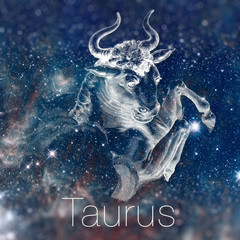
On the Hebrew zodiac, Taurus the Bull, was Joseph’s sign, split into 2 horns, for Ephraim and Mannasseh; [Num. 2:18-20, Deut. 33:17], his two sons. This allowed a substitution the rebellious tribe of Dan, in a circle of 12 tribes of Israel. This allowed for the Levitical 13th tribe to be placed in the center of the zodiac’s circle, with the pattern of the stars mirrored in Israel’s seed, as they camped around their Tabernacle in the wilderness of Sinai during their forty years of wandering. The Sun’s relation to the 13th tribe of Levites, may be an Intercalation allusion to a 13th month, aligning solar & lunar cycles in the Hebrew Calendar. The Levites, being the priestly tribe, had the charge of affairs for the Tabernacle, housing the Ark of the Covenant. An aspect of the Tabernacle’s celestial plan can be found in the edifice of the wooden framework that provided a foundation upon which the Tabernacle’s curtains [H3407]#23 (Ps. 104:2-3, Isa. 40:22, Ex. 26:26-36), hung. Their assembly was 48 units, each ten cubits high, and 1.5 cubits wide…#24 This implies a structure to these 12 zodiacal signs including their 36 decans, (12+36=48) divided into ten degree decans, showing not only God’s celestial order in the Tabernacle of the Sun [Ps. 19:4], but also marking the earthly Tabernacle as the focal point reflecting the spiritual light of God’s presence among His people during the Old Testament. This was established in the priestly order of service instituted in the Temple by King David, with 24 courses of priests, each serving twice during Israel’s calendar year, totaling 48 weeks. When the 3 weeks of Passover, Pentecost and the Feast of Tabernacles are included, wherein all the priests served, we have the 51 weeks of Israel’s luni-solar year, divided according to sacred and civil standards. The sacred year began in Nisan, the month of the spring Passover, while the civil year in the fall started in the seventh month–Tishri 1, the Day of Trumpets signaling the onset of Israel’s holiest month. This depicts the Creator’s light reflected in the celestial structure of Creation, ruling over the Hebrew’s timekeeping, manifest in the sacred priestly service and architecture of the Old Testament Tabernacle and Temple, fulfilled in Jesus Christ as King and High Priest, after Melchizedek’s order.
As stated above, the Hebrew words for “going forth” are mowtsa [*H4161], meaning the dawn, the east, a gate, the rising of the sun. Upon closer view, the root of “mowtsa” [H4161], is [H3318–yatsah–to go, go forth, bring out in a great variety of applications]. #25 To Germinate or expand as a plant; [Gen. 8:19, Job 29:4-25, God knows the goings out and comings in of Leviathan;
Num. 33:2, Job 41:20-21, Isa. 13:10-13, 37:28-9, in reference to the serpentine constellations, or Dragon Decans like Draco, Hydra, Cetus, & Serpens]. The various serpent constellations mentioned here represent different areas of power in manifestation in the adversary’s Kingdom, and their part in the Celestial Gospel. God knows all that the enemy is up to, and by His perfect Omniscient Wisdom and foreknowledge, He knew He would need a special warrior class of Archangel, like Michael & his Angels, even before Lucifer’s failed heavenly revolt in the First Heaven and Earth. A Messianic Prophecy in Micah 5 sheds added light here.
Micah 5:1-2
5:1 Now gather yourself in troops, O daughter of troops; a state of siege has been placed against us. They shall smite the ruler of Israel with a rod (a scepter) on the cheek. 2 But you, Bethlehem Ephratah, you are little to be among the clans of Judah; [yet] out of you shall One come forth for Me who is to be Ruler in Israel, Whose goings forth have been from of old; [H6924-Qedem: positioned to the east, Gen. 2:8-eastward in Eden- is a positive connotation for East, as Gen. 11:2 is negative in reference to Babylon’s Astrology & the tower of Babel. #26 It also means “Antiquity;” [Ps. 74:12-15, 77:5-6, 11-12, 23:7-9]. This Hebrew noun is unusual in that it has both a geographical and temporal meaning, as does Precession, that refers to the four points of the compass, and the ages of the Precession of the Equinoxes. It occurs 61x in the Heb. OT, having a definite flavor of an idyllic state. #27 One Heb. synonym is [H5769–owlam, a word for ancient Days, or everlasting] that also means (eternity). Owlam- is what is hidden or concealed, to the vanishing point, time immemorial, from the most ancient times. [Gen. 6:4, 1 Sam. 27:8, Isa. 63:16, 64:4-5, Ps. 25:6, distant future-past, without end, perpetuity, everlasting time, in plural it means multiple ages], #28 as in the context of Precessional ages compared to Biblical dispensations, or Ages. This also carries with it the tone or spirit of an Age [zeitgeist] as seen in the signs and Constellation symbols tied to specific Ages of Precession. [see Plate 3 Chart below]
Micah 5:3-6
3 Therefore shall He give them up until the time that she who travails has brought forth; then what is left of His brethren shall return to the children of Israel. 4 And He shall stand and feed His flock in the strength of the Lord, in the majesty of the name of the Lord His God; and they shall dwell [secure], for then shall He be great [even] to the ends of the earth. 5 And this [One] shall be our peace. When the Assyrian comes into our land and treads upon our soil and in our palaces, then will we raise against him seven shepherds and eight princes among men. 6 And they shall rule and waste the land of Assyria with the sword and the land of Nimrod within her [Assyria’s own] gates. Thus shall He [the Messiah] deliver us from the Assyrian [representing the opposing powers] when he comes into our land and when he treads on our borders.
The Plate 2 graphic of the Dendera Zodiac below shows the Pegasus Square, as a square scroll laid between the two Fishes of Pisces, with “Axis E” of this famed Egyptian Zodiac, running through the corner of it. As we stated in our website study on the Stars of the Dendera Zodiac: the main Taurus-Scorpius Axis of this zodiac, with the Leo-Aquarius axis, match the main axes that identify the Age of Taurus in the Bible, in Numbers 24:7-9. The context of Numbers 2 shows us the order of 12 tribes of Israel in their wilderness encampment, matching the zodiacal order of the 12 signs/constellations on the ecliptic. In this way, the Dendera Zodiac not only provides key evidence of Archaeology how the ancient Hebrews and Egyptians both utilized a practical knowledge of the precession of the equinoxes, but in the Hebrew’s case, they applied it directly to their belief in a prophecy of their coming redeemer, with Nature’s verification of the Celestial Gospel, in support of the Holy Writ of the Old Testament Scriptures, as the Creator spun the Sun, Moon and Stars in synch with His prefect Precessional timing in the Celestial Gospel.
Thus, the Zodiac of Dendera also provides strong supporting evidence from the history of Biblical Astronomy as to the belief in a coming redeemer, since this ancient Egyptian zodiac prophesies in very specific ways not only concerning the time he would appear, but also concerning his unique sacrifice via the very same celestial imagery utilized in the Bible. This important theme is set forth in John Lash’s realization of the presence of a 5th Axis on this Zodiac, from Spica, the brightest star in Virgo. #29 The Hebrew name for Spica [Al Zemach]-the Branch/offspring of God, [Jer. 23:5-6] is embodied in God’s only begotten Son– Jesus Christ. Spica is only one of just two stars specifically marked on the Dendera Zodiac, the other being Sirius, the central star linked to the flood stages of the Nile, and the Sothic Calendar, logging one of it’s oldest historical Calendar dates, 4241 BC. The 1461-year Sothic calendar also conforms to the 260-day pattern of the Mayan Tzolkin Calendar [260 x 1461] that equals 365.25 x 1040 days, adhering to the pattern of Jupiter-Saturn conjunctions, as they break down the windows of the precession of the equinoxes through the ages.
Plate II. Axis “E” on the Dendera Zodiac #

John Lash’s comments concerning this 5th Dendera Axis are enlightening when viewed in context of the history of the Hebrew’s in ancient Egypt with Abraham, Isaac, Jacob and Moses, as a forerunner of Christ, and Lawgiver of Israel, who led them through the wilderness unto the Promised Land. As Lash states in his unpublished book, The Skies in Memory:
“The Dendera Zodiac’s inventor was looking ahead to our time in the Piscean Age, when the spring equinox occurs under the tail of the western fish, since this is the time that the entire cycle culminated. With the spring equinox at this position in Pisces, the axial cross locks in unique alignment with the Galaxy.” Lash goes on to say that he considers the star “Spica… to be the master key to the Dendera Zodiac…”#29
The Dendera Zodiac marks our Piscean Age with the first appearance of the Branch and offspring of God, seen in how “Axis E“ referenced above, coincides with the star Spica and the opening of the Age of the Fishes, that later marked the moments of his birth in 3 BC. In the Plate 2, chart above marking Axis E as the 5th axis of the Dendera Zodiac, extending from Spica, in the Virgin’s hand, via the North Pole in the Jackal’s paw, across the 2 fishes of Pisces to the Ram-headed altar on the periphery of the Dendera Zodiac, that neatly bisects this altar. The altar shows 4 Ram heads of the Egyptian idol Banebdjedet, of Mendes–sailing on his solar barque across the heavens, as pictured on the astronomical ceiling in the outer Hypostyle hall of the Temple of Hathor at Dendera. In the design of the famed circular Zodiac at Dendera, the internal [precessional time] & external [lunar-decans design] depicted a coordinated solar-lunar circuit. When Axis E [line unifying Virgo/ Leo, of the Great Sphinx] intersects Pisces the Fishes, it depicts the alignment with the Spring/Vernal Equinox– a precessional prophecy of Christ’s birth. As Axis E extends to the Zodiac’s periphery crossing the lunar decan of a 4-headed Ram god of Egypt, whose 4 faces orient to the four directions of the Compass.
Figure 4. The Four headed Ram god of Egypt; Banebdjedet.#30
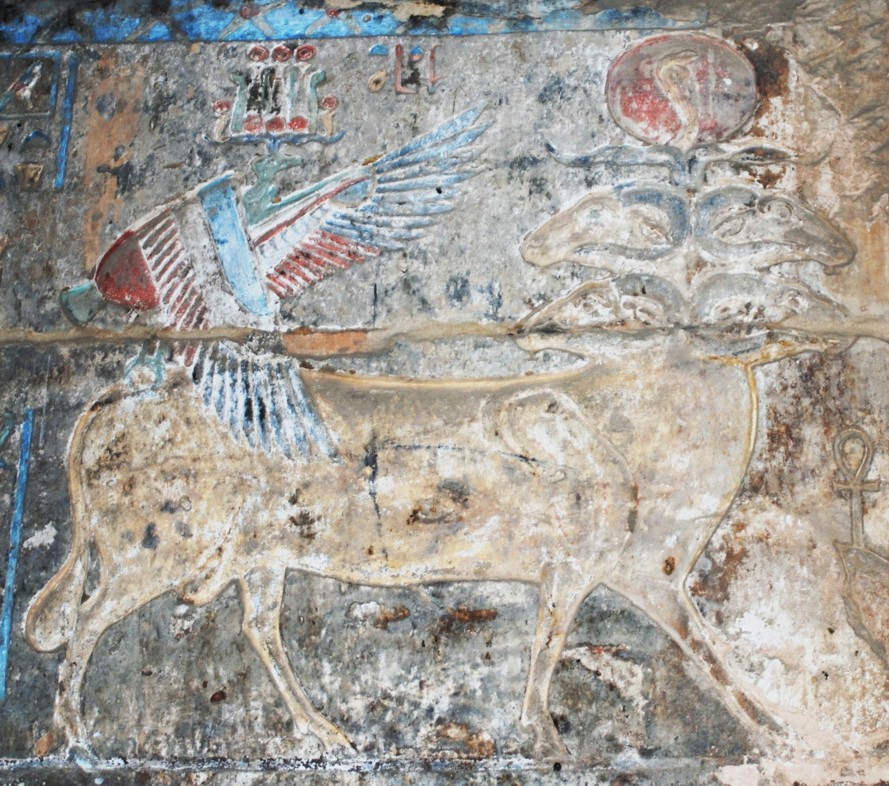
Like the positive aspects of the Cherubim were depicted, as a special class of Angels who are always prominent in God’s throne-room, so the four-headed Ram god of Egypt, whose four faces are a shadow of these “four royal signs” on the zodiac, as the Cherubim ruling the four-corners or celestial pillars of heaven, previously seen in Numbers 24. This collective pairing of 8 idol gods– the Ogdoad spirits [four Diamon pairs], held the Cardinal direction positions in the 1st Heavens and Earth. Were they the key actors in its flooding, under Lucifer? [2 Pet. 2:4 “hell“=[G5020-tartarus; confined in a special place for judgment due to their unique sin; Jude 6. #31 In Greek Myth, Tartarus was the deepest area in the underworld, a prison and place of torment and suffering for the wicked, akin to the lake of fire, and the second death in Scripture or a place of destruction. The Satanic angel condemned to the bottomless pit called Apollyon in Greek, [G630], [Abaddon-H11] in Hebrew, [Rev. 9:11]. It was also the name of the god who symbolized the pit; with Sheol in Job 26:6-7, Ps. 88:10-12.]
As the mythology of the Great Sphinx preserved some truths of Gen. 49:8-10, and the Jupiter-Regulus triple union starting Sept 14th 3 BC, with the birth of Christ, so also we find correlations to the flood of 2 Pet. 3:6, that destroyed the 1st Heavens and Earth, in Dendera’s extension of Axis E. The Almighty-Creator God used the 10 Plagues over Egypt to prove His supreme, Omnipotent power over the false idols of Egypt. Each plague was directed at the impotent gods of the Egyptian pantheon, so that Egypt would witness first-hand, the identity and power of Jehovah. As the Lord Jehovah is the only Self-existent and Eternal God, Moses relayed the message God told him on the holy Mount, (Exo 7:5). Jehovah showed He was the Almighty Sovereign–Creator in these 10 plagues, and that He controls all that exists on the Earth. The Lord used Moses as an apostle by whom the plagues would be brought to bear over the Pharaoh and Egypt, with a primary goal that the plagues would cause Pharaoh to free the nation of Israel from slavery.
The List of 10 Plagues over Egypt
- Aaron’s staff turned the Nile waters to Blood: Exodus7:14-25. The idols judged: Hapi: the God of annual flooding; Osiris: The Nile River was his bloodstream.
- Aaron’s staff again brought the plague of Frogs: Exodus 8:1-15. The gods judged: Hapi and Hegt the goddess seen with a frog’s head related to fertility.
- Lice: These were tiny, stinging, blood sucking gnats from the dust. Exodus 8:16 -18. The god judged: Seb: the earth god.
- Flies that came in swarms: Exodus 8:20-32. The gods judged: Hathor: the goddess of protection; Vatchi: fly God.
- Livestock die: Exodus 9:1-7. The god judged: Apis: the bull god.
- Boils on the body: Exodus 9:8-12. The god judged: Sekhmet: goddess of epidemics.
- Hail and Fire: Exodus 9:13-15. The gods judged: Nut; the sky goddess; Seth: God of storms; Shu: God of the atmosphere/wind.
- Locusts: Exodus 10:1-20. The gods judged: Sirius: crop god; Serapia: protector of crops.
- Darkness: Exodus 10:21-29. The gods judged: Ra: the sun god who was most worshipped God in Egypt.
10. Death of the First Born: Exodus 11:1-12:36. The gods judged: Heget: goddess of birth; Min; the God of reproduction. Deliverance from death was only thru the offering of the Passover lamb. As a result of the plagues; both Pharaoh and the Egyptians beg Moses and Israel to leave Egypt. God fulfilled His promise to free Israel. #32
The ancient iconography of the Egyptian 4 headed Ram god was part of a pantheon of 8 idol gods–the Ogdoad, or 9 Ennead idols with Atum/Khnum, the Nile waters Supreme male guardian, in four pairs of idol consorts in ancient varied Myths, in On-Heliopolis, & Thebes. Their first reference is a primeval-first Earth mound, arising out of the Chaotic waters of Egyptian Creation Myth, all sharing a common source in the demiurge-Nun & Naunet’s watery Chaos. Kek & Kauket–was darkness innate in the waters. The denizens of the Deep; opposite the Material world of the living, mirrored a Concealed and invisible-Amun & Amaunet-air goddess. While Heh & Hauhet–were the undirected watery chaos extending to infinity. These 8 gods of the Ogdoad, ruling the 1st cosmos, conceived as a collective in Four pair, of Ram-Headed man-wife couples, forming the idol-god Banebdjedet. Can Egyptian Creation Myth, shed light on the destruction of the 1st Heavens and Earth in Genesis 1:1-2?
Atum gave rise to the male Wind god Shu and his wife-sister, Tefnut; whose union made an empty void between the Earth god Geb-tied to the Lice plague, and the Sky goddess Nut, linked to the Hail plague. In comparing the Hebrew and Egyptian texts, where the union of these spirits of the god and goddess of Earth and Sky, caused an empty void to form, similar to the Bible’s formless void– “tohu va bohu,” What intrigues me; in Gen. 1:2 is the seeming symbiotic relation in the Chaos and Darkness of the formless void, where the confusion powers the darkness, in the heart of this Chaos. This darkness is opposed to the light, but its symbiotic nature brings to mind the structure of the 4 pairs of man-wife couples seen above. Since the enemy is parasitic, having no good original thoughts of his own, he knows he can’t top the Creator’s perfection, so as the Adversary can’t top a symbiotic symmetry that the Almighty-Creator must have first installed in the Angelic cohorts of the 1st Heaven & Earth, the serpent corrupted God’s first plan for Angels, to maximize his control over the counterfeit order of his spirit realm.
As we follow Axis E–the unity line between Virgo and Leo of the Great Sphinx, at the one end of Dendera’s Zodiac, this unity line embodies other marriages between the four pair of Ogdoad couples, with one uniting the Divine twins Shu (at left) and Tefnut (at right, lioness-headed); or Adam and Eve, that the Tempting Serpent used to divide them, causing the fall of mankind in Eden. The Egyptian rendition of Adam and Eve is seen on the astronomical ceiling of the Temple of Hathor below, at Niteyóre (Dendera)
Figure 5. Gemini the Divine twins Shu (left) and Tefnut (right) on Dendera Zodiac.#33
The root of the original Hebrew-Syriac word for “Gemini” according to Seiss; “does not run so much on the idea of two brought forth at the same birth as “twins,” but more on the idea of something completed, as a year come to the full, or a long betrothal period brought to consummation in perfected marriage.” #34 This lends to our grasp, not of a short period in Original Paradise, but a longer period closer to a 2,160 yr. Precessional Age.
The following Chart shows how Precessional Ages correlate with the Biblical Administrations, revealing a consistent progression of spiritual themes as God’s Plan of the Ages to deliver mankind via the Messiah unfolds. This provides the overarching context for God’s redemption and restoration plan for Mankind and Creation, in the redeeming work of Christ-a Centerpiece of the Ages. The ancient Egyptian, version of Gemini’s Zodiac Sign seen in the Divine twins Shu and Tefnut, would thus match the Precessional Age of Gemini with dates from 6480-4320 BC, seen below corresponding to Adam and Eve in Original Paradise.
Plate III. Precessional Ages Aligned with Biblical Administrations
| Zodiacal Sign/Age | Biblical Admins | Heavens & Earth | Precession Age Start Dates BC |
Scripture |
| Cancer | Angels 1st Estate | 1st H & E | 8640-6480 | Gen. 1:1-2 |
| Gemini
Aries Pisces Pisces
|
Original Paradise
Patriarch’s O.T. Law Christ-Rev. Final Paradise |
2nd H&E
2nd H&E 2nd H&E 2nd H&E
|
6480-4320
2160-7 BC 7BC-2153 AD ?
|
Gen. 3:8ff
Ex. 19:16ff Matt. 3:11ff
|
This march of the Precessional Ages is recorded in ancient star maps like the Dendera zodiac, in a recognition of the axes built into its structure. As noted, the concept of this progression of Bible History based on the Ages of Precession, is a general introduction, where the apparent links to the Age of Gemini, to the Bible Age or Administration of Original Paradise, when God made, formed and Created Adam and Eve, as the first man and wife, are detailed. The dates of the Precessional Age of Gemini fall in line with general parameters of dating a “Young Earth Creation,” but with added supporting legitimacy seen in the Biblical evidence of Precession of the Equinoxes, going back to Joseph through Abraham and Adam. The solid Biblical evidence of Precession proven in Scripture, was first presented on my [Try-God.com] website in early 2003.
In his classic book “The Gospel in the Stars,” Dr. Joseph Seiss says: “Regarding the sign Gemini, “the Twins were said to be initiated into all the Mysteries, and were invited guests at a great Marriage, where a severe conflict occurred.”#35 In Greek Myth they were considered invincible warriors and specifically seen as friends and protectors of navigation, as on the ship from Alexandria that Paul sailed on from Malta, on his journey to Rome; named Castor and Pollux, [Acts 28:11]. In myth, as patrons of great powers over the four winds & good fortune over-seas, [Jer. 49:36] they were in company too with Jason and his crew of Argonauts contending for the Golden Fleece; the sacrificial hide of the Lamb. Seiss notes that in ancient stellar pictures of the Denderah Zodiac, the twin figures were not of one sex, as seen below where a man is seen hand-in-hand walking with a woman, and have been referred to as Adam & Eve. #36
In the Prophecies of the Celestial Gospel in the 12 constellation-signs, the Man is the 1st Adam, while 2nd Adam-Jesus Christ, is with his foreshadowed Bride-the Messiah-Prince, in the 1st Adam with Eve; the 2nd Adam; destined for a glorious union with his Bride in everlasting dominion, with the Church of his spiritual body.
Figure 6. The Quadrangular Zodiac at Dendera. #37

In the upper left corner of this Quadrangular Zodiac of Dendera we find the sign Gemini, as a man-wife couple sailing together in their barque, similar to the image below from the circular Dendera zodiac.
For our purposes here, it appears plausible that Gemini’s zodiacal position prior to the Age of Taurus, depicted as the first couple; Adam & Eve certainly fits the chronology of Precessional Ages, according to our understanding of the Biblical Administrations. The Age of Gemini would have been the Age of Innocence in the Garden of Eden for Adam and Eve, made in God’s image and likeness, in Eden, with dominion over all the earth, [Gen. 1:26].
Figure 7. Gemini on the classic Circular Dendera Zodiac.
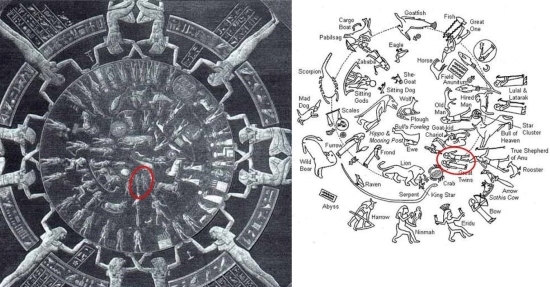
In these above renditions of the circular Dendera Zodiac we can see Gemini as the man-wife couple circled in red above, and below, between Taurus the Bull, and Cancer the Crab, or in ancient Egypt-the Scarabaeus.
Figure 8. Enlarged Man-Wife color image of Gemini in Figure 7.#38

The Figure 9 graphic below provides a summary of the complete cycle of the Ages of Precession as a Sine Wave, with significant Biblical Patriarchs from Adam leading to Christ-the 2nd Adam. Here the Age of Gemini matches with Adam, omitting the attempt to justify 13 Billion years of “evolution” in an effort to exclude the Almighty Creator from His Creation.
Figure 9. Sine Wave/Menorah graph of Long Term History [pinterest.com] #39.

I trust you enjoyed this expanded view of Precession and I look forward to your comments and questions.
God’s Abundant Blessings to you All!!
Rene’
Footnotes
1. Figure 1 picture credit [https://humanoriginproject.com/precession-equinoxes/]
2. Strong’s Concordance, [G3772–ouranos] James Strong.
3. IBID, [G2889-kosmos].
4. IBID, [G165–aion].
5. Figure 2. picture credit [VectorStock/30349471]
6. Strong’s Concordance, [H2822-choshek:], James Strong
7. IBID, [H2896; towb].
8. IBID, [H914-badal].
9. Figure 3 picture credit, Laws of Thermodynamics [Pinterest.com]
10. Strong’s Concordance, [H8432-“tavek“], James Strong
11. IBID, [H7097-qatseh].
12. IBID, [H8398-tebel].
13. IBID, [H7097-qatseh].
14. IBID, [H8622-tequphah].
15. IBID, [H8398-tebel].
16. IBID, [*H4161-mowtsa].
17. IBID, [H8622–tequphah].
18. IBID, [H7812-shachah].
19. IBID, [H4427-malak].
20. IBID, [H4910-mashal].
21. IBID, [H7812-shachah].
22. IBID, [H7812-shachah].
23. IBID, [H3407-yeriyah].
24. KJV Bible, Exodus 26:26-36
25. Strong’s Concordance, [H3318–yatsah], James Strong
26. IBID, [H4161-mowtsa].
27. IBID, [H6924-Qedem].
28. The Hebrew-Greek Key Study Bible, in Lexical Aides to the OT. [H5769–owlam]
29. IBID, [H5769–owlam].
30. The Atlantis Blueprint, Colin Wilson & Rand Flem-Ath, ppg. 171-172.
31. Figure 4 picture credit;[https://en.wikipedia.org/wiki/Banebdjedet#/media/File:Mendeswidder.jpg]
32. Strong’s Concordance, [G5020-tartarus], James Strong
33. Dr. Gary Baker-independent columnist for The Atascadero News and Paso Robles Press; email him at pastor@gracebaptistpaso.org.
34. Figure 5 picture credit; [Amentet Neferet – Religion and Traditions of Ancient Egypt]
35. The Gospel in the Stars; Joseph Seiss, p.113.
36. IBID, p. 112
37. [https://ayinyhvh.wordpress.com/2016/07/01/on-the-possible-meaning-and-origins-of-the-zodiacal-sign-gemini-shu-and-tefnut-and-the-zodiac-of-dendera/]
38. IBID, The Quadrangular Zodiac at Dendera.
39. IBID, Figure 8 picture credit; [https://ayinyhvh.wordpress.com/2016/07/01/on-the-possible-meaning-and-origins-of-the-zodiacal-sign-gemini-shu-and-tefnut-and-the-zodiac-of-dendera/]
